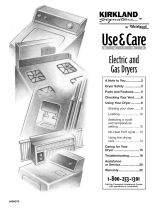
iMPORTANT SAFETY iNSTRUCTiONS
WARNING - To reduce the risk of fire, electric shock, or injury to persons when using the
dryer, follow basic precautions, including the following:
-,Read all instructions before using
the dryer.
-,Do not dry articles that have been previ-
ously cleaned in, washed in, soaked in,
or spotted with gasoline, dry-cleaning
solvents, other flammable, or explosive
substances as they give off vapors that
could ignite or explode.
-,Do not allow children to play on or in
the dryer. Close supervision of children
is necessary when the dryer is used
near children.
-,Before the dryer is removed from service
or discarded, remove the door to the
drying compartment.
-,Do not reach into the dryer if the drum
is moving.
-,Do not install or store the dryer where
it will be exposed to the weather.
-,Do not tamper with controls.
-,Do not repair or replace any part of the
dryer or attempt any servicing unless
specifically recommended in this Use and
Care Guide or in published user-repair
instructions that you understand and have
the skills to carry out.
-,Do not use fabric softeners or products to
eliminate static unless recommended by
the manufacturer of the fabric softener or
product.
-,Do not use heat to dry articles containing
foam rubber or similarly textured rubber-
like materials.
-,Clean lint screen before or after each load.
-,Keep area around the exhaust opening
and adjacent surrounding areas free from
the accumulation of lint, dust, and dirt.
-,The interior of the dryer and exhaust duct
should be cleaned periodically by qualified
service personnel.
-,See Installation Instructions for grounding
requirements.
- SAVE THESE INSTRUCTIONS -




















